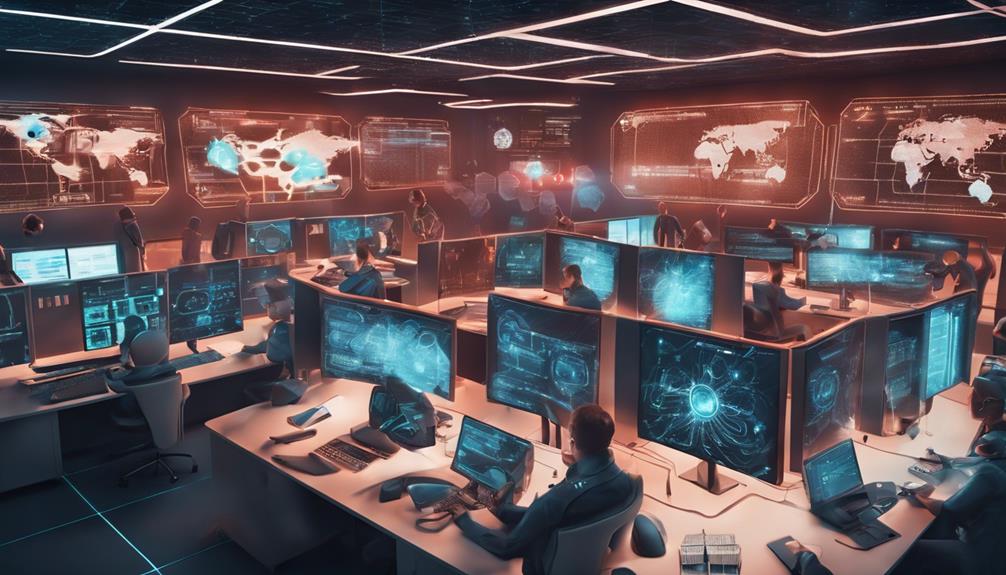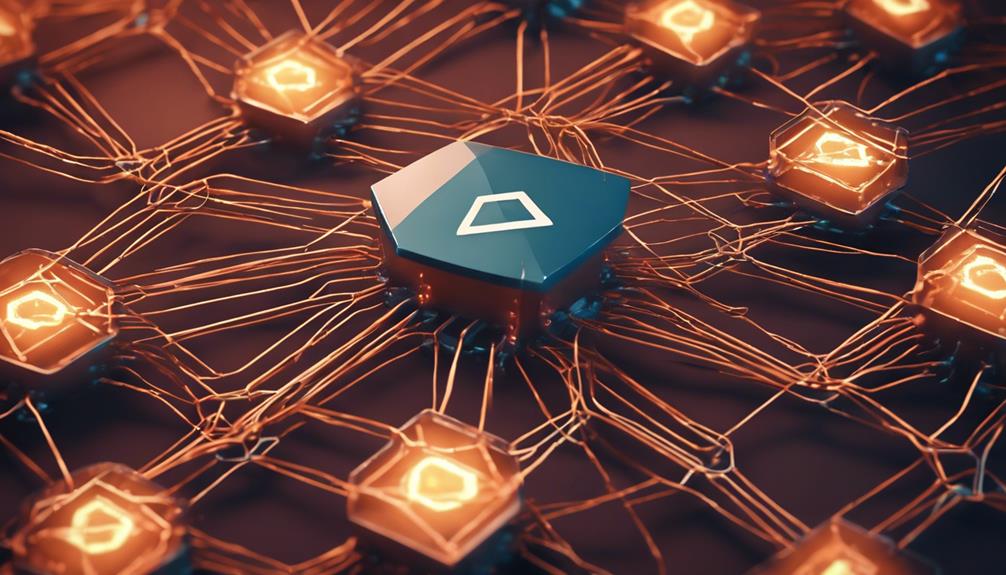AI cybersecurity companies like Darktrace, CrowdStrike, and Guardz are pioneering digital defense with self-learning AI algorithms for threat detection. Their innovative use of AI and machine learning strengthens security postures, offering advanced solutions for threat identification and mitigation. Companies such as SentinelOne, Tenable, and Lacework utilize cutting-edge AI technologies to revolutionize cybersecurity practices. Palo Alto Networks, Trend Micro, and Zscaler lead with AI-based security strategies for fortified defenses. These industry leaders demonstrate the power of AI in reshaping cybersecurity landscapes. Discover more about these advanced AI cybersecurity solutions for proactive digital defense.
Key Takeaways
- Darktrace, CrowdStrike, and SentinelOne are top AI cybersecurity companies driving digital defense innovation.
- Advanced AI technologies from Lacework and Deep Instinct bolster threat detection capabilities.
- Leading innovators like Anduril and Shield AI focus on AI-driven solutions for national security.
- Companies like Palantir and Hawkeye 360 provide mature AI services for defense strategies.
- AI cybersecurity companies prioritize threat detection, prevention, and proactive security measures.
Innovative AI Cybersecurity Companies
Several innovative AI cybersecurity companies have emerged in recent years, revolutionizing the industry with cutting-edge technologies and advanced threat detection capabilities. Darktrace stands out for its self-learning AI algorithms that power the Enterprise Immune System, enabling autonomous threat detection and response. Utilizing Machine Learning (ML), Darktrace continuously adapts to identify new threats in real-time, enhancing cybersecurity defenses.
Another key player, CrowdStrike Falcon, introduced in 2011, combines cloud and on-device elements for advanced threat detection through user and entity behavior analytics (UEBA). This approach allows CrowdStrike to proactively identify suspicious activities and potential breaches, bolstering cybersecurity measures effectively.
Guardz, a newcomer founded in May 2021, offers a SaaS platform equipped with innovative tools for Phishing, Ransomware, and Data Loss Prevention. Additionally, Guardz provides a unique insurance policy to further safeguard organizations against cyber threats, showcasing a holistic approach to cybersecurity defense.
These AI cybersecurity companies leverage cutting-edge technologies like ML to provide robust threat detection capabilities, ensuring businesses can stay ahead of evolving cyber threats.
Advanced AI Defense Solutions

AI cybersecurity companies such as CrowdStrike, Darktrace, and Palo Alto Networks are at the forefront of developing and implementing advanced AI defense solutions for robust threat detection and prevention. These companies harness AI-driven cybersecurity solutions to enhance security effectiveness through advanced AI technologies.
- Utilization of Machine Learning: AI cybersecurity companies focus on leveraging machine learning algorithms to continuously improve threat detection capabilities.
- Autonomous Security Operations: Companies like SentinelOne and Tenable offer autonomous security operations powered by AI to effectively combat evolving cyber threats.
- Enhanced Security Posture: Integration of AI technologies in cybersecurity solutions from Fortinet and Trend Micro enhances overall security posture and threat detection capabilities.
- Innovative Solutions: Leading innovators like Lacework and Deep Instinct provide advanced AI technologies that offer innovative solutions for digital defense, staying ahead of cyber adversaries.
Cutting-Edge Cybersecurity Innovators

Cutting-edge cybersecurity innovators like Anduril, Epirus, and Shield AI are at the forefront of developing top AI solutions for digital defense.
Their advanced threat detection capabilities, powered by AI and machine learning, are revolutionizing how organizations combat cyber threats.
Top AI Solutions
Leading the charge in innovative cybersecurity solutions, prominent companies such as Darktrace, Crowdstrike, and Palo Alto Networks are at the forefront of leveraging AI technology for advanced threat detection and prevention.
- Utilizing Advanced Machine Learning Algorithms:
These companies harness sophisticated machine learning algorithms to bolster security effectiveness and shield organizations from the constantly evolving landscape of cyber threats.
- Key Platforms:
Darktrace's Enterprise Immune System, Crowdstrike's Falcon platform, and Palo Alto Networks' Cortex platform are prime examples of AI-driven cybersecurity solutions that proactively combat threats.
- Autonomous Response Capabilities:
AI solutions from these industry leaders offer autonomous response capabilities, real-time threat detection, and personalized threat identification, enhancing overall security posture.
- Focus on AI Integration:
With a strong emphasis on AI integration in cybersecurity, these companies continue to refine digital defense strategies, ensuring robust protection against sophisticated cyber threats.
Advanced Threat Detection
Prominent cybersecurity innovators in the industry are excelling in advanced threat detection through the strategic implementation of artificial intelligence technology. CrowdStrike stands out with its AI-native defense approach, offering cutting-edge capabilities in identifying and mitigating threats swiftly.
Darktrace sets itself apart by utilizing self-learning AI algorithms that adapt in real-time to provide personalized threat detection. Vectra AI is another key player, leveraging AI to efficiently detect, investigate, and respond to cyber threats proactively.
Trellix focuses on advanced threat prevention, utilizing AI-guided investigations and targeted malware scans to enhance security measures effectively. Additionally, Sprinto enhances cybersecurity solutions by offering automation capabilities that streamline threat response processes.
These companies showcase the power of AI in fortifying digital defenses, illustrating how self-learning AI and AI-native defense are pivotal in staying ahead of evolving cyber threats. Through their innovative approaches, they pave the way for a more secure digital landscape.
Leading AI Security Providers

How do top AI cybersecurity companies utilize advanced technologies to enhance threat detection and prevention capabilities? These leading innovators in digital defense harness the power of AI to safeguard against cyber threats effectively.
Here are some ways these providers excel in AI security:
- Abnormal Security, Darktrace, and SentinelOne leverage AI for dynamic threat detection, rapidly identifying and mitigating potential risks.
- CrowdStrike and Deep Instinct employ AI and machine learning to bolster security measures, offering proactive defense mechanisms against evolving cyber threats.
- Palo Alto Networks and Trend Micro develop AI-based cybersecurity solutions to adapt to changing threat landscapes and fortify overall security resilience.
- Zscaler pioneers a Zero Trust SASE approach, utilizing adaptive AI algorithms for continuous risk evaluation and strengthening remote access security.
These companies showcase how AI security can revolutionize cybersecurity solutions, providing advanced protection in an increasingly digital world.
AI-Powered Digital Defense Leaders

AI-Powered digital defense leaders exemplify the forefront of innovation in cybersecurity, revolutionizing the landscape with cutting-edge technologies. These companies leverage AI to enhance security measures and advance threat detection capabilities, ensuring a proactive approach to safeguarding digital assets. Darktrace and Anomali, for instance, stand out for their utilization of AI and ML algorithms to detect and respond to evolving threats in real-time, bolstering cybersecurity operations with unparalleled efficiency.
Below is a table showcasing some of the key players in the domain of AI-driven digital defense:
| Company | AI Utilization | Focus Area |
|---|---|---|
| Anduril | AI-driven solutions | Security enhancement |
| Shield AI | Intelligent autonomy | Threat detection |
| Palantir | AI-enhanced decision-making | Situational awareness |
These AI pioneers like Shield AI are not only reshaping military strategies but also influencing the broader cybersecurity landscape with their innovative approaches. By prioritizing AI integration in digital defense, these leaders are propelling the industry towards a more secure and proactive future.
Top AI Cybersecurity Innovations

Explore the cutting-edge domain of AI cybersecurity innovations, where advanced threat detection and autonomous security solutions are revolutionizing the digital defense landscape.
Companies like Darktrace, Palo Alto Networks, Fortinet, Crowdstrike, and Zscaler are at the forefront of leveraging AI to proactively identify and mitigate cyber threats.
AI Threat Detection
The domain of AI threat detection in cybersecurity is continuously evolving with innovative solutions from leading companies like Darktrace, CrowdStrike, Cynet, FireEye, and Check Point.
- Darktrace: Darktrace stands out as a pioneer in using AI for threat detection, employing self-learning algorithms that adapt to new threats in real-time.
- CrowdStrike: CrowdStrike Falcon integrates cloud and on-device components with user and entity behavior analytics (UEBA) to enhance its threat detection capabilities.
- Cynet: Cynet offers autonomous breach protection alongside endpoint security, incorporating response automation to swiftly address threats detected through behavioral analytics.
- FireEye: Specializing in threat intelligence, FireEye provides advanced threat detection services, leveraging its expertise in incident response to fortify cybersecurity defenses.
These companies are at the forefront of leveraging AI and behavioral analytics to enhance threat detection capabilities, helping organizations stay ahead of cyber threats in an increasingly digital landscape.
Autonomous Security Solutions
Revolutionizing the world of cybersecurity, autonomous security solutions powered by artificial intelligence are redefining threat detection and response capabilities. These cutting-edge technologies leverage AI to autonomously identify and mitigate security threats, providing a vital defense approach.
By offering real-time monitoring and adaptive defense mechanisms, AI-driven autonomous security solutions guarantee continuous protection against evolving cyber threats. Leading AI cybersecurity companies are at the forefront of developing and implementing these advanced solutions to enhance overall security posture.
Autonomous security solutions play an essential role in fortifying cybersecurity measures by swiftly detecting and neutralizing threats before they can cause harm. The seamless integration of artificial intelligence into security operations enables organizations to stay ahead of malicious actors and safeguard sensitive data effectively.
Embracing autonomous security solutions is imperative in the ever-changing landscape of cybersecurity to bolster defenses and mitigate risks proactively.
AI Companies Redefining Cyber Defense

AI companies are transforming the landscape of cyber defense through innovative technologies and strategic solutions. These cybersecurity firms harness the power of AI to enhance threat detection, using data-driven approaches to bolster digital security.
Here are some notable AI companies redefining cyber defense:
- Anduril, Epirus, Shield AI, Helsing, and Rebellion:
These companies are at the forefront of national security and defense, leveraging advanced technology solutions to tackle evolving cyber threats effectively.
- Darktrace and Anomali:
By incorporating AI and machine learning, these companies offer personalized threat detection capabilities and cost-effective security analytics, helping organizations stay ahead of potential breaches.
- Palantir:
Known for providing mature AI services for defense purposes, Palantir's solutions are instrumental in shaping robust defense strategies.
- Hawkeye 360:
Specializing in space-based technology, Hawkeye 360 enhances situational awareness in defense operations, proving its effectiveness during real-world events like Russia's invasion of Ukraine.
Future-Forward Cybersecurity Innovations

Innovative advancements in cybersecurity are paving the way for future-forward digital defense strategies. AI-powered tools are revolutionizing the cybersecurity industry, offering proactive threat prevention measures to combat evolving cyber threats effectively. By harnessing the capabilities of artificial intelligence and machine learning, cybersecurity companies are enhancing security effectiveness and reshaping defense strategies.
These forward-thinking innovators prioritize threat detection and prevention, providing cutting-edge solutions to safeguard organizations from malicious activities. Through the integration of AI-driven innovations, companies are able to fortify security postures and offer autonomous security operations that can adapt to the ever-changing cyber landscape.
The future of cybersecurity lies in the proactive utilization of AI technologies to bolster threat intelligence capabilities and establish robust defense mechanisms. By embracing these future-forward cybersecurity innovations, organizations can stay one step ahead of cyber adversaries and protect their digital assets with confidence.
Frequently Asked Questions
What Cyber Security Company Uses Ai?
In the domain of cybersecurity, the integration of AI technologies has become paramount. One prominent company utilizing AI for threat detection and response is Darktrace. By harnessing self-learning algorithms, Darktrace enhances digital defense capabilities against evolving cyber threats.
Which Company Is Leading in AI Technology?
In the domain of AI technology, Darktrace is a prominent leader due to its self-learning AI algorithms and Enterprise Immune System for threat detection. Their innovative approach sets them apart in the field of cybersecurity.
Who Is the World Leader in Autonomous Cyber Ai?
The world leader in autonomous cyber AI is Anduril Industries, renowned for its cutting-edge software engineering and autonomous sensemaking capabilities tailored for military applications. Their focus on innovation and excellence sets them apart in this field.
What Company Is Leading the AI Revolution?
In the field of AI revolutionizing cybersecurity, Darktrace emerges as a frontrunner. With a remarkable 93% detection rate of never-before-seen threats, Darktrace's self-learning AI algorithms and enterprise immune system set the pace for digital defense innovation.
Conclusion
In the domain of cybersecurity, AI companies stand as the valiant knights defending against the relentless attacks of digital adversaries. Their innovative solutions and cutting-edge technologies serve as the shining armor protecting our digital territories.
As these AI-powered defenders continue to push the boundaries of cyber defense, we can rest assured that our digital fortresses will remain secure in the face of ever-evolving threats.
Trust in the prowess of these cybersecurity innovators to safeguard our digital future.









